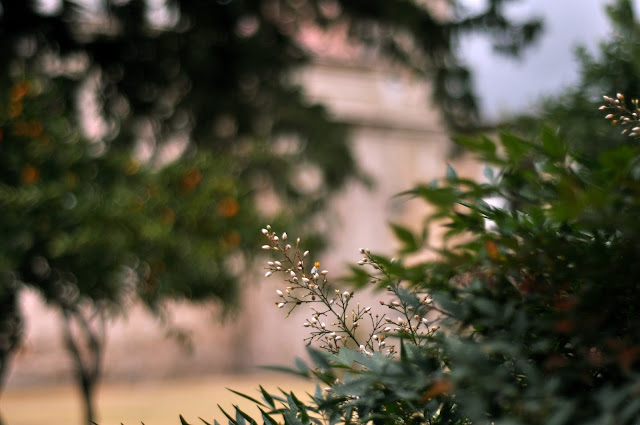this week, i've been lucky enough to get to explore outside of the city, and in the process have gained a lot of perspective on argentine history and culture, which has been quite enlightening.
on sunday, marit and our friend malin and i took a bus to alta gracia, a town about 50 minutes south of córdoba, for a day trip. the town itself was strangely empty, in part because it was a sunday, but it felt like a ghost town. it took us ages to find the town center, because even the main areas felt barren and desolate. a few houses we passed reminded me of a series of unfortunate events in their eery, rundown faded glory. clearly, alta gracia's prime had come and gone several decades (or even centuries, we soon learned) ago.
one of the two main attractions in the town is the ernesto "che" guevara museum, which exists now in the house that he lived in for 12 years of his youth. exhibited were items ranging from childhood photos and report cards, to che's famed motorcycle, to, disconcertingly enough, his personal correspondence with his dear friend fidel... castro, that is.

i don't know if i can describe with enough emphasis the iconic status that che- he has one name here, like oprah or bono- holds in the argentine consciousness. his face adorns walls, t-shirts, and even souvenir maté cups all over the country.
the other main sight in alta gracia was la estancia jesuítica, a jesuit church complex dating back to the spanish conquest in the 17th century. the town of alta gracia was founded around the estancia, which was one of 6 jesuit estancias, or ranches, built in the early 1600s by spanish jesuits in order to fund the school that is now the universidad nacional de córdoba. in 1767, a decree from the spanish king expelled the jesuits out of argentina, at which point franciscans took over care of the estancia until the jesuits returned a century later. now, la manzana jesuítica y estancias de córdoba is a world heritage site, and functions as a museum.
the entire day was a glimpse into argentina's colonial past and also into its more recent fascination with che guevara, who is widely viewed as a transcendently heroic figure here.
yesterday, i ventured into the even more (terrifyingly) recent past, as everyone from the human rights program took a field trip to visit la perla, the largest secret detention center of the province during the military dictatorship.
during the latter half of the 1970s, thousands of people were systematically kidnapped, tortured and executed there. our human rights coordinator described la perla as "córdoba's auschwitz," a title which, upon visiting, proved strikingly accurate.
 |
| postcards containing memories of la perla as told by survivors. |
la perla considers itself to be a centro cultural and a memorial, not a museum, because although it offers information and historical perspective, its main goals are to honour the victims and to create a conversation with the visitor about questions of philosophy and morality. our tour guide made frequent comparisons and contrasts with nazi germany, the french control of algeria, and guantanamo bay, to make it relevant to our group of mixed nationalities. at one point, as we examined a map which marked all of the clandestine torture centers in the area circa the dictatorship, our guide reminded us that there was still a city underneath these speckled locations of horror- a city which tried its best to continue living, breathing, working, as best it could during this era of state-sponsored chaos.
 |
| an art installation in which artists painted symbolic messages and images on 37 doors from the centro, repurposing them as a tribute to the lives lost. |
 |
| the current legal status of the perpetrators, who are finally being tried for their crimes. |
 |
| a touching note written from a nephew to the uncle he never knew. |
 |
| the jacket that one victim was wearing when he was abducted- if you look closely, you can see the damage done to it as he fought in vain to avoid kidnapping. |
this week has otherwise been a haze of work and hanging out with friends and work and doing laundry and work and buying groceries and work and going to the gym and work and eating a lot of granola bars. marit and i are going to buenos aires this weekend, though! we've bought bus tickets and booked a hostel, but that's as far as we've gotten so far. planning session to figure out sightseeing destinations commences this afternoon as soon as we get through our marathon weekly friday afternoon human rights meeting. we're going to try to pack as much into our 2 days in BA as humanly possible, so stay tuned for photos.
xo
m














































No comments:
Post a Comment